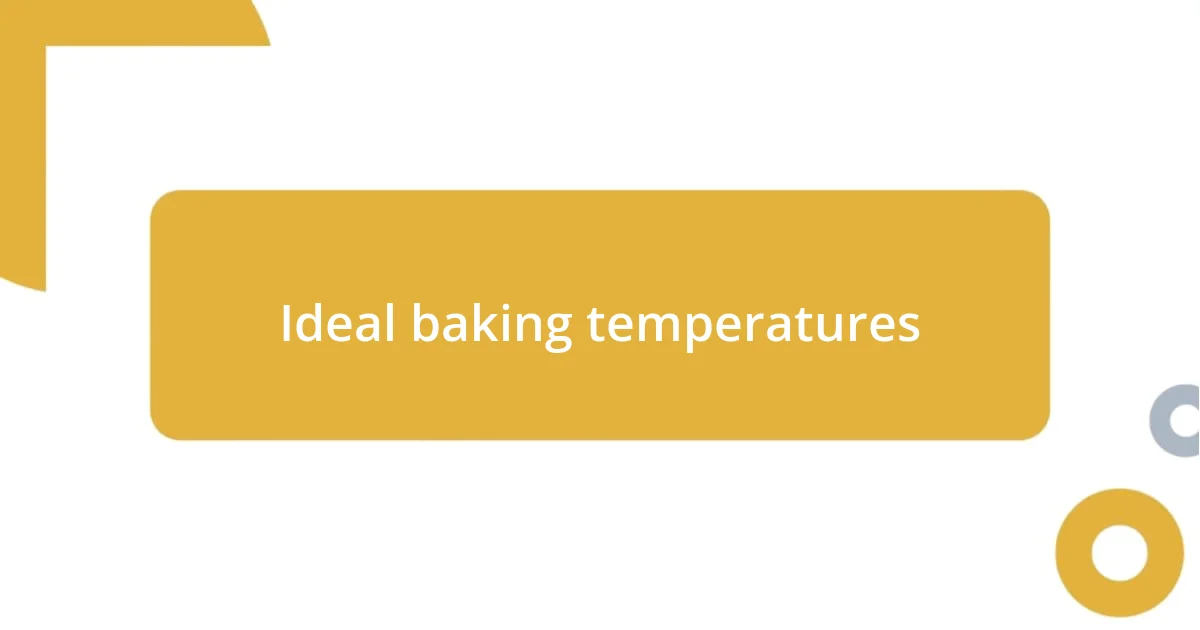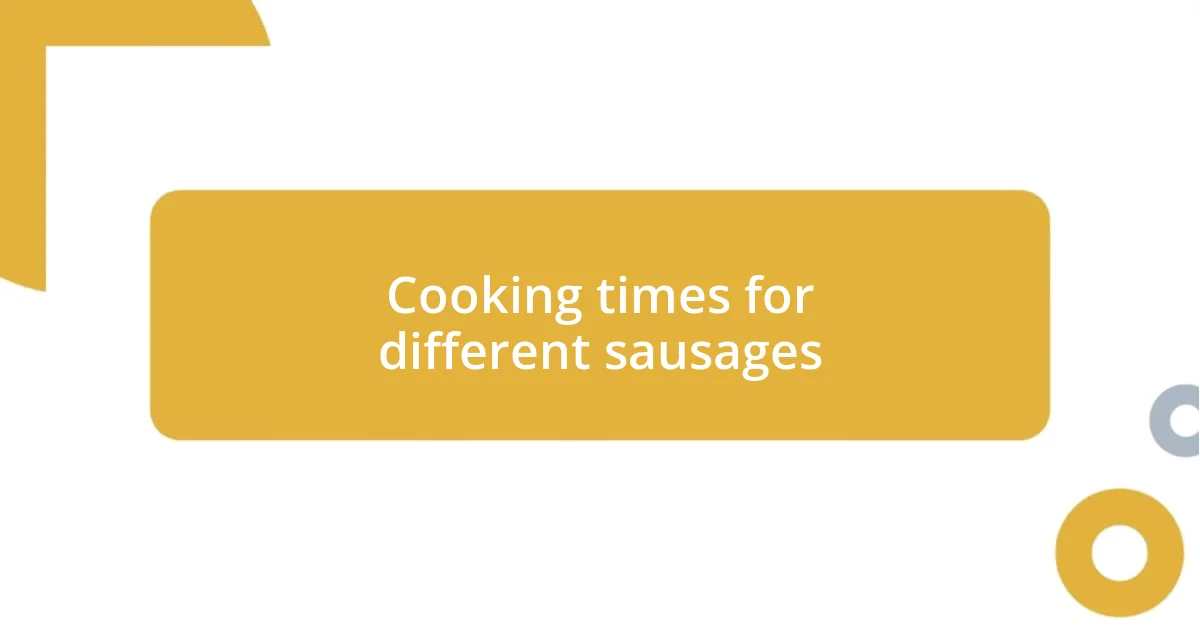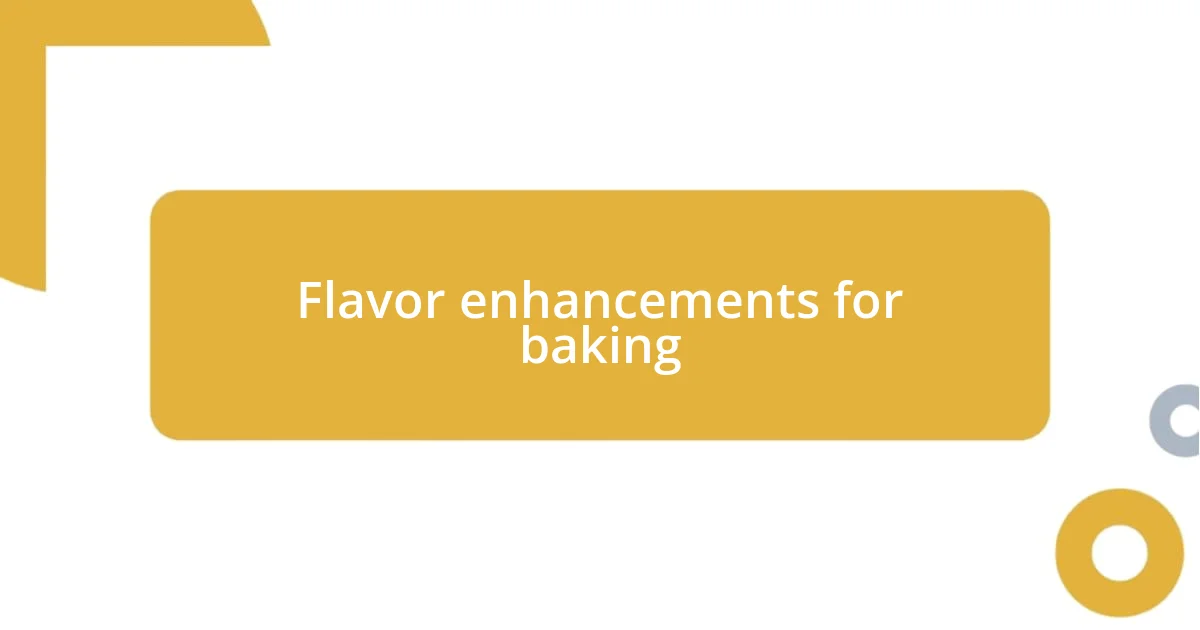Key takeaways:
- Temperature control is crucial for baking sausages; preheating the oven and checking internal temperatures ensures even cooking and safety.
- Flavor enhancements, such as marinating and using fresh herbs or spices, significantly elevate the taste of baked sausages.
- Avoid overcrowding the baking pan and ensure to preheat the oven to achieve that desired crispy, golden exterior on sausages.

Understanding sausage types
When diving into the world of sausages, I was surprised to discover the sheer variety available. From spicy chorizo to sweet Italian sausage, each type carries its unique blend of flavors and seasonings. I often wonder, how can something as simple as ground meat transform into so many mouthwatering options?
One of my personal favorites is bratwurst. I remember the first time I tried it at a summer cookout; the combination of the savory, seasoned meat with hints of nutmeg and ginger brought such warmth. It’s fascinating to think about how regional cuisines influence sausage types. Have you ever considered how much a local culture shapes its food traditions, especially with something as versatile as sausage?
Exploring the differences between fresh, smoked, and dried sausages can be thrilling. Fresh sausages need to be cooked through, while smoked varieties often add that unique depth of flavor without requiring extra cooking. I find myself constantly experimenting: could you imagine the joy of pairing smoked sausage with a tangy mustard, and letting the flavors dance on your palate? It’s a simple pleasure that brings me back to the joy of discovery in every bite.

Best baking techniques
When it comes to baking sausages, I’ve learned that temperature control is key. I always preheat my oven to around 400°F (200°C) before placing the sausages inside. This ensures they cook evenly, resulting in that beautiful crispy exterior while maintaining juiciness on the inside. A memorable moment for me was the first time I tried this technique; the sausages came out perfectly browned, and my friends couldn’t get enough!
Here are some techniques that I recommend:
– Use a baking sheet lined with parchment paper: This simplifies cleanup and prevents sticking.
– Turn the sausages halfway through baking: This promotes even cooking and an appetizing color all around.
– Consider adding veggies: Tossing in bell peppers or onions not only enhances flavor but also makes for a colorful, hearty dish.
– Check internal temperature: Ensure the sausages reach at least 160°F (70°C) for safe consumption; I always use a meat thermometer for peace of mind.
– Baste with honey or BBQ sauce in the last few minutes: This adds an extra layer of flavor that turns a simple dish into something really special.

Ideal baking temperatures
When it comes to baking temperatures, I think consistency is crucial. I typically find that aiming for a range between 375°F (190°C) and 425°F (220°C) can yield great results. It allows the sausages to develop a delightful caramelization on the outside while ensuring they cook thoroughly. Once, when experimenting, I set my oven to 375°F and ended up with juicy sausages that paired beautifully with a side of roasted veggies.
I’ve also discovered that the thickness of the sausage can affect cooking time and temperature. Thicker sausages tend to need a little more heat or time to cook through, while thinner ones can become dry if cooked too long at high temperatures. I remember one Friday night, I mistakenly baked thinner sausages at 425°F for too long; they were crispy on the outside but not juicy, which I found disappointing. It taught me that watching the clock, especially with the type of sausage, is just as important as the temperature.
Lastly, using an oven thermometer has truly changed my baking game. I often find my oven fluctuates from what the dial suggests, affecting my sausage bake. Just the other day, I loaded the oven with some delightful bratwursts, confident in my usual routine, but realized my oven was slightly cooler than I thought. Luckily, I caught it in time, and the sausages came out just right! Investing in an oven thermometer was one of the best decisions I made.
| Temperature (°F) | Temperature (°C) |
|---|---|
| 375 | 190 |
| 400 | 200 |
| 425 | 220 |

Cooking times for different sausages
When it comes to cooking times for various types of sausages, I’ve discovered that it really varies by type. For standard pork sausages, around 25 to 30 minutes at 400°F (200°C) tends to be perfect. I learned this the hard way; one time, I confidently took a batch out at the 20-minute mark, thinking they looked great, only to find they were undercooked. I remember feeling that knot of concern in my stomach—it taught me the importance of patience in cooking.
Beef sausages, on the other hand, generally need a little longer, often around 30 to 35 minutes to reach that safe internal temperature of 160°F (70°C). I recall hosting a barbecue and assuming beef sausages would cook at the same rate as my trusty pork ones. I ended up serving some slightly pink, less-than-ideal sausages, and let me tell you, the look on my friends’ faces was enough to make me double-check the cooking times from then on. I always recommend using a meat thermometer—it’s such a peace of mind!
Now, when I bake chicken sausages, I find they can be quite quick, often needing just 20 to 25 minutes, which always surprises me. I remember the first time I baked them, I was skeptical and checked continuously, thinking surely they needed more time. I was amazed to see them perfectly cooked and juicy after just 22 minutes! It’s fascinating how each type of sausage has its unique sweet spot, wouldn’t you agree?

Tips for crispy coatings
When I think about achieving that perfect crispy coating on sausages, a light dusting of flour can make all the difference. The first time I tried this, I was skeptical. But watching the flour brown and crisp in the oven was a revelation! It created a delightful crunch that paired so well with my favorite dipping sauce. Isn’t it satisfying when a simple technique transforms a meal?
Another tip I swear by is using a little oil on the sausages themselves before baking. I remember the first time I skipped this step—I pulled them out thinking they’d been perfectly cooked, only to find they were beautifully browned on one side and oddly dull on the other. A quick brush of oil ensures even crispiness, so every bite delights. Have you ever wondered why some dishes just pop with flavor while others fall flat? This little detail is often the secret.
Lastly, I’ve learned that broiling for the last few minutes can elevate the texture. There was a night when I was juggling dinner for friends and, feeling adventurous, I turned on the broiler. The sausages came out with a golden, bubbly crust that had my all the guests coming back for seconds. Isn’t it incredible how a small adjustment can lead to such delicious rewards?

Flavor enhancements for baking
When it comes to flavor enhancements for baking sausages, marinating them beforehand can really take the taste to the next level. I remember the first time I soaked some chicken sausages in a mix of apple cider vinegar, garlic, and herbs. The next day, as they baked, the entire kitchen filled with this intoxicating aroma that made my mouth water. Have you ever experienced a dish that had everyone asking for the recipe before the meal even started? This simple step added layers of flavor that just blew my mind!
I’ve also discovered that adding a sprinkle of seasoning right before baking can really elevate the taste. Once, I experimented with smoked paprika and cracked black pepper, just for fun. The flavors melded perfectly as they cooked, creating this mouthwatering crust that was both savory and slightly spicy. It’s those little, extra touches that can turn an ordinary dish into something special. What’s better than taking a bite and having that burst of flavor surprise you?
Another method I’ve found intriguing is the use of fresh herbs. A handful of chopped rosemary or thyme tossed on top of the sausages while they bake can transform the dish entirely. I can still recall the delight I felt when I first tried this with some spicy Italian sausages. The combination of the herby scent mingling with the meaty aroma was heavenly, and each bite was a flavor explosion. Have you tried infusing your dishes with fresh ingredients? I truly believe it’s one of the most rewarding ways to experiment in the kitchen!

Common mistakes to avoid
One common mistake I see is overcrowding the baking pan. I once rushed a meal and piled the sausages on top of each other, only to pull out a tray of pale, slightly steamed links instead of the crispy, golden beauties I desired. It’s crucial to give them space; otherwise, they won’t roast properly. Have you ever experienced that disappointing moment when your main dish just doesn’t live up to expectations because of a simple oversight?
Another pitfall is skipping the preheating phase. I’ll admit, on one busy weeknight, I tossed my sausages into the oven without waiting for it to heat up. The results were far from appetizing—an uneven cook with a rubbery texture. Preheating not only ensures proper cooking but also enhances flavors and caramelization. So, do yourself a favor and take those few extra minutes; it really makes a difference!
One mistake I’ve often made as well is not checking the internal temperature. I remember thinking that a timer was all I needed. There was that one time I pulled out what I thought were perfectly cooked sausages, only to discover they were still a bit pink inside. It’s a lesson learned! Using a meat thermometer ensures safety and proper doneness, giving you peace of mind. Isn’t it comforting to know that with just a little attention, you can elevate your sausage-baking game?















